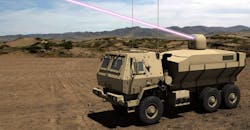Optical and electromagnetic (EM) energy in many forms have been key components for the modern battlefield. In that vein, the U.S. Army has devoted its High Energy Laser (HEL) Tactical Vehicle Demonstrator (TVD) program to try to develop a 100-kW laser system that defends against incoming missiles and drone aircraft. An important part of the development program, which involves Raytheon Co., Lockheed Martin, and many other leading defense contractors, is making the laser compact and energy-efficient enough to be readily transported on tactical all-terrain vehicles. In its current state, the HEL system is deployed on a six-wheel truck, which is considered too cumbersome for tactical missions. By modifying and redesigning the laser systems, the goal is to make it deployable on standard tactical vehicles (see figure).
The U.S. Army’s High Energy Laser (HEL) Tactical Vehicle Demonstrator (TVD) program is devoted to making more compact weaponized lasers. (Courtesy of Lockheed Martin)
In addition to its laser components, the HEL TVD includes a communications, command, and control (C3) subsystem for receiving targeting instructions from a base camp or from headquarters. The U.S. Army is planning to perform a demonstration of available HEL TVD technology against a range of targets during fiscal year (FY) 2022. As a backup, the military service is also working on a lower-power version of the laser system, at 50 kW, called the Maneuver Short Range Air Defense (M-SHORAD) system. It’s being designed for installation on a Stryker combat vehicle.
The Army’s FY 2020 budget request for $262.1 million in funding for 44 M-SHORAD systems covers the upgrade for that number of Stryker combat vehicles. With the growing number of air-based threats, including missiles and unmanned aerial vehicles (UAVs), this use of directed-energy weapons has been posed by the Army as a more cost-effective defense, in terms of cost per shot.
About the Author
Jack Browne
Technical Contributor
Jack Browne, Technical Contributor, has worked in technical publishing for over 30 years. He managed the content and production of three technical journals while at the American Institute of Physics, including Medical Physics and the Journal of Vacuum Science & Technology. He has been a Publisher and Editor for Penton Media, started the firm’s Wireless Symposium & Exhibition trade show in 1993, and currently serves as Technical Contributor for that company's Microwaves & RF magazine. Browne, who holds a BS in Mathematics from City College of New York and BA degrees in English and Philosophy from Fordham University, is a member of the IEEE.


